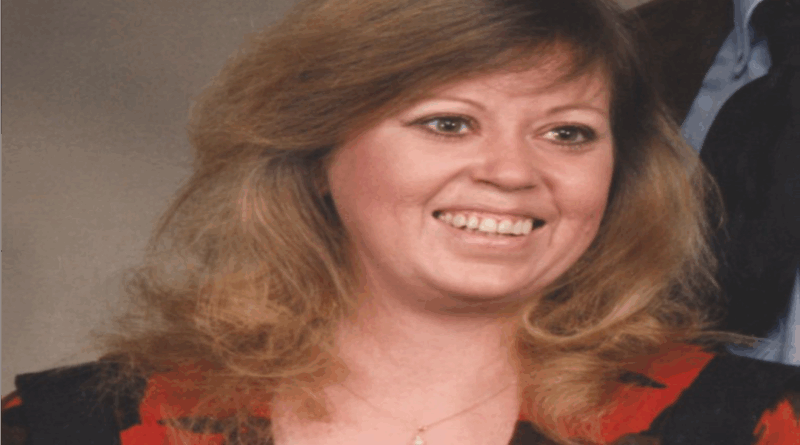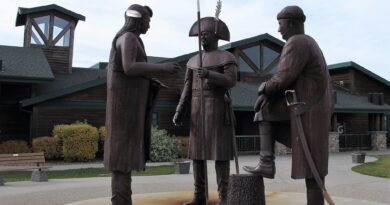Penny Peeler Disappears After Argument With Her Husband in Enid Oklahoma
On the evening of April 25, 1990, 37-year-old Penny Yvonne Peeler telephoned her mother from the Enid/Carrier area of north-central Oklahoma. She was upset and candid: marital problems had worsened, arguments had become recurring, and she felt adrift between what she wanted for herself and the expectations closing in around her. That call—mundane in its logistics, heartbreaking in hindsight—became the final confirmed contact anyone in her family had with Penny. In the days that followed, routine gave way to silence: no more phone calls, no visits, no bank activity that relatives could recognize, no verified sightings that would anchor her in time or place. What began as a family’s anxious waiting evolved into a cold file labeled a suspicious disappearance.
Who Penny Was
To understand a disappearance, it helps to sketch the person who vanished. Penny was a daughter, a spouse, a friend. She carried the practical intelligence of someone who made a household run and the social intelligence of someone who kept relationships stitched together. She was known for a ready smile that hid worry, and for a sense of duty that could make her carry burdens longer than she should. She navigated life in the Enid/Carrier area, a patchwork of town and countryside where wheat fields and wind define the horizon and where neighbors keep tabs because distance demands it. Penny was not fleeting or rootless; she had a web of people who expected to see her again the next day, and the next.
The Enid/Carrier Setting
The geography matters. Enid was and is a logistics hub—rail lines, trucking routes, highways fanning out toward Amarillo, Oklahoma City, and points west. Carrier sits just northwest, smaller, quieter, stitched into the same fabric. In 1990 the region felt open and practical. Long-haul trucks rolled through, and bus stations offered cheap, real-world mobility that didn’t always leave a paper trail. That mobility is a double-edged sword in a missing-person case: it creates plausible paths out of town and provides cover for conflicting narratives about where someone “went” next.
A Marriage Under Stress
By Penny’s account to her mother, her marriage of many years to Glenn “Bud” Peeler Jr. was strained. Money, expectations, and day-to-day resentments had started to harden. Arguments can be cyclical; each new one inherits the emotional debt of the last. Penny’s last known remarks framed her stress as ongoing—not a single explosive event, but the accumulative weight that makes options feel narrow. People close to her later said she did not sound like someone who was abandoning her life; she sounded like someone seeking a plan.
The Timeline That Follows
After April 25, the public record reduces to fragments. Within two days of that call, her husband left on a trip that would span roughly from April 27 to May 11, according to later summaries. The exact purpose and company on that trip are subjects of retrospective ambiguity. What is clear is that in the midst of that timeline, a date appears: May 3. That date later became the fulcrum of conflicting statements about where Penny supposedly was seen and by whom.
Conflicting Reports of the “Last Sighting”
One account placed Penny at an Albuquerque truck stop on May 3, 1990, as if she had been en route west or drifting along interstates, a familiar image in cases that lack hard anchors. Another account surfaced that she was seen that same date at a Sacramento bus station—farther west, more definitive in distance, but no easier to corroborate without tickets, phone cards, or an independent witness willing to sign a statement. Both locations share attributes: they are long-haul nodes, places where people come and go, where a single day can pass tens of thousands of faces through. Both are credible enough to tell a story; neither has been verified by records available to the public. When a case turns on a contested waypoint, investigators lean hard on documentation—surveillance, receipts, independent witnesses. In 1990, such documentation was rarer and more perishable than it is today.
The Immediate Response
Families often hesitate to declare someone missing when the situation might be explained by a cooling-off period after an argument. That hesitation costs time. When Penny didn’t call back, people waited a day, then another. Phone trees stirred; friends drove by; relatives asked around. Eventually the uncertainty hardened into concern: Penny wasn’t at work, wasn’t answering, wasn’t showing up where she would ordinarily be. Law enforcement received the report and began the standard early-stage steps: confirm the last independent contact, check hospitals and jails, pull threads on financial and communication activity, and test the strength of any “last seen” statements for corroboration.
What Investigators Faced in 1990
The early 1990s were not friendly to timeline-heavy investigations without a body or a crime scene. Phone bills existed but cell-site data did not. Surveillance cameras were sporadic and low-resolution. Bus and train manifests were often handwritten and inconsistently archived. Credit cards were used less, and cash left few footprints. Without a sudden forensic break—an abandoned vehicle, a personal effect, a recovered garment—detectives were left to circle back through interviews and hope inconsistencies would reveal themselves.
Absence of Physical Evidence
No publicly reported scene emerged: no blood evidence, no vehicle failure, no dropped purse that could be tied to an event. Without a scene, a disappearance remains an absence rather than a documented crime. That legal and investigative gap matters. Suspicion can be high, but charges require evidence. Leads occasionally surfaced—rumor of a ride, speculation about a motel, a friend-of-a-friend claiming a sighting—but none produced the kind of documented foundation that lets an investigator write a probable cause affidavit.
The Family’s Long Vigil
Families of the missing live in a space where grief never gets permission to complete its cycle. Penny’s relatives kept calling, writing, checking, and re-checking. Anniversaries became markers not of celebration but of the time the world refused to cooperate. They repeated the facts they were sure of: Penny loved her people, she had reasons to stay, and if she had left on her own, someone would have heard from her by now. Over time, hope and skepticism trade places. Loved ones will say, “I just want the truth,” and they mean it, even if the truth is hard.
Theories That Have Been Considered
Several frameworks recur in a case like Penny’s:
Voluntary departure. Perhaps she left to clear her head or to start anew. The counterpoint is life’s inertia: responsibilities, relationships, patterns. People who walk away often still make a call, send a postcard, touch an account, or resurface with a bureaucratic footprint. The long-term silence undermines the voluntary-departure theory.
Harm close to home. Statistically, intimate partners and people in one’s close circle are overrepresented in acts of violence that follow domestic stress. That is a pattern, not a proof. Investigators test alibis, travel windows, and statements. Contradictions about last-seen locations, if any, are pressure-tested against documents. In Penny’s case, the contradiction itself is not a charge; it is a signpost to areas of further inquiry.
Encounter on the road. Long-haul routes through the Plains and Southwest have their own criminological footprint. Occasional serial predators targeted truck stops and bus depots during that era. If Penny was on the move—by choice or under pressure—she could have intersected with opportunistic harm. But this theory requires placing her at one of those nodes with independent corroboration, which the public record does not provide.
Accident with no recovery. In rural America, single-vehicle accidents, misadventure near water, or getting lost can explain certain disappearances. Usually, however, vehicles are recovered or scenes are eventually found. The absence of such a discovery after decades lowers the probability of this scenario, though it cannot be fully excluded.
Why the Accounts Matter
Whenever an investigation hinges on statements about where someone was last seen, investigators look for fixed points: dated receipts, toll logs, motel registries, time-stamped surveillance. By triangulating those artifacts, they can test whether a stated location is even feasible. Albuquerque and Sacramento on the same date imply significant travel. Without corroboration, both remain claims. If either were true, a secondary trail (even faint) should exist: a bus ticket stub, a clerk who remembers the interaction, a call from a payphone captured on a long-distance bill. The absence of such anchors is not dispositive, but it forces the case back toward the earlier, more certain waypoint—Penny’s April 25 call to her mother.
The Investigative Plateau
Cold cases often plateau at the point where all the initial interviews have been conducted, obvious search areas canvassed, and known timelines assembled. Leads grow older; witnesses move; memories fade. What sustains them are periodic reviews, new technology, and sudden human developments: a conscience loosens, a relationship fractures, an unrelated arrest produces a detailed jailhouse conversation. Agencies periodically re-evaluate: Is there physical evidence that could yield DNA today that could not in 1990? Are there unexamined phone records that might be digitized and text-searchable? Did any offender later confess to crimes along the corridor that could overlap the timeline?
How the Passage of Time Helps and Hurts
Time erodes memory but clarifies patterns. People who lied early can contradict themselves decades later. Conversely, good-faith witnesses forget small, crucial details. For investigators, the best use of time is technological. A single latent print can now be compared globally. A speck on clothing—if preserved—can be analyzed for trace materials unthinkable in 1990. Even the humble motel registry, if scanned, can be cross-referenced for names that later appear in offender databases. The challenge is that many ephemeral records from 1990 were never saved.
The Emotional Economy of a Cold Case
A disappearance like Penny’s creates two simultaneous stories: the procedural story of an investigation and the emotional story of a family. The procedural story moves in docket notes and evidence logs. The emotional story moves in holidays with an empty seat, birthdays not celebrated, phone calls that end in silence. These stories intersect in interviews, where family members must again recite what they remember, and in media outreach, where they carefully separate hope from speculation.
What Would Move the Case Today
Several catalysts could turn a stagnant file into a solvable case:
Independent corroboration of place. A verifiable artifact—like a dated photo, a reliably logged transaction, or a contemporaneous letter—placing Penny in Albuquerque or Sacramento (or anywhere else) on or near May 3 would reset the investigation’s center of gravity.
A physical trace. Discovery of a personal item in a context that implies struggle or concealment would transform the classification from disappearance to a likely crime, opening new legal tools and priority.
A statement with verifiable specifics. People sometimes come forward years later with information. The key is verifiability. A true insider account often includes details never made public and can be tested against known but undisclosed facts.
Technological re-analysis. Revisiting preserved items—if any exist—with modern DNA or trace analysis can unlock previously invisible leads.
Lived Possibilities and Respectful Restraint
It is responsible to articulate possibilities and irresponsible to convert them into accusations without evidence. Penny’s disappearance contains elements that make certain theories tempting: the timing of the last call, the marital stress, the contradictory last-seen stories, and the lack of independent verification. The right posture is disciplined humility: hold the patterns in one hand and the absence of proof in the other. The goal is not to be coy; it is to preserve the integrity of the open search for truth.
The Role of Community Memory
Cases like Penny’s live partly in official binders and partly in community memory. A clerk might remember a woman who matched her description asking about routes to California. A neighbor might recall a vehicle idling late at night that did not belong on the road. A classmate might have received a letter and misfiled it. The value of community is not in rumor but in recall: specific, dated, testable recollections that can be compared against known times and places.
Why Names and Dates Matter
Cold cases are susceptible to drift. Over time, dates become approximate, and names blur. Fixing the anchor points keeps the case from unraveling. April 25, 1990: the call to her mother. Early May: contested claims of a sighting far from home. Enid/Carrier: the origin environment. The more precisely those anchors are preserved, the less room there is for narrative inflation to fill the gaps with speculation.
The Human Cost of Uncertainty
Disappearance is a unique kind of loss: no funeral, no definitive shift from searching to mourning. Family members often speak in dual sentences—“If she’s out there, I want her to know we love her; if something happened, I want justice.” That duality can last a lifetime. The community’s role is to hold space for both possibilities without turning curiosity into spectacle.
Practical Avenues for Information Holders
If someone believes they once encountered Penny or heard a relevant comment:
- Write down everything remembered, even if it seems minor: dates, locations, vehicles, clothing, routes, comments, and the names of others present.
- Describe the context first (why you were there) and your observation second (what you saw).
- Separate what you personally observed from what you later heard from others.
- If you possess an artifact—an old photo, a journal entry, a letter—preserve it exactly as it is and share a copy, not the original, until law enforcement requests custody.
Specificity beats certainty. “I am 60% sure it was the first week of May because I had just cashed a paycheck on the 1st” is more useful than “It was sometime in spring.”
What Justice Might Look Like
Justice is not only a criminal conviction. It can be the recovery of remains, the confirmation of a fate, or the correction of a narrative that has been wrong for decades. For families, even an answer without a courtroom can be a form of long-delayed mercy. For communities, an answer restores confidence that the truth is findable, even after years of quiet.
The Enduring Question
In the absence of a scene, a confession, or a document that nails down the contested May 3 waypoint, Penny Yvonne Peeler remains where she has been for decades: present in memory, missing in record. The last certain image we possess is of a woman on a phone, telling her mother the truth about how hard things had become and signaling, intentionally or not, that she needed someone to listen. That is where the case begins, and until something new appears, that is where it waits.
A Call to Remember Penny
Behind labels like “suspicious disappearance” is a person with a life’s worth of days. Penny’s case is not an abstract puzzle; it is the story of a daughter who called home, a woman whose routines suddenly ceased, and a community that lost one of its own. Remembering her accurately—name, date, place, and context—is the first duty. The next is remaining open to the possibility that the fact that unlocks everything has been sitting in someone’s memory all along.
Discover more from City Towner
Subscribe to get the latest posts sent to your email.




